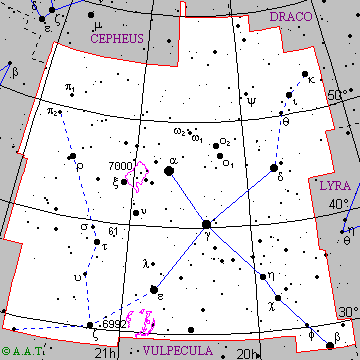 |
 |
| English name | Swan | ||||
|---|---|---|---|---|---|
| Major stars | alpha Cygni | Deneb | magn. 1,3 | RA: 20h 41m 25.93s | Dec: +45° 16' 49.3" |
| beta Cygni | Albireo | magn. 3,2 | RA: 19h 30m 43.31s | Dec: +27° 57' 34.6" | |
| gamma Cygni | Sadr | magn. 2,3 | RA: 20h 22m 13.71s | Dec: +40° 15' 24.1" | |
| delta Cygni | magn. 3,0 | RA: 19h 44m 58.52s | Dec: +45° 07' 50.6" | ||
| epsilon Cygni | magn. 2,6 | RA: 20h 46m 12.62s | Dec: +33° 58' 12.2" | ||
| zeta Cygni | magn. 3,4 | RA: 21h 12m 56.18s | Dec: +30° 13' 37.2" | ||
| Description | Very evident constellation, known also with the name of Northern Cross, because of its characteristic shape. It is situated in a zone of the sky crossed by the Milky Way, close to Lyra. The brightest star of the constellation, Deneb (from Arab, "tail"), is a white-blue supergiant 2000 light-years away: it is therefore the most distant first magnitude star. With Vega of Lyra and Altair of Aquila, Deneb forms the so-called Summer Triangle. Another interesting star is Albireo, a double constituted by a yellow component of third magnitude and by a green-blue component of fifth magnitude: with good binoculars you can separate it. Other remarkable double stars are omicron1 Cygnis, formed by an orange giant of magnitude 4 and by a blue giant of magnitude 5, and 61 Cygnis, a couple of orange dwarf which are only 11,1 light-years away. The constellation of Cygnus contains a pair of famous nebulas. On the border with Vulpecula there is the Veil Nebula, an enormous gas ring, residual of a supernova explosion happened around 50.000 years ago. The brightest part of the Veil Nebula, NGC 6992, can be observed with good binoculars in excellent wheather conditions: to see the whole nebula you need instead big instruments and long-exposured photos.
Near eta Cygni there is probably a black hole, that was denominated Cygnus X-1: it is sucking in the gases of a neighbouring star of ninth magnitude, so producing a strong X-ray emission. |
||||
| Mythology and history | Hyginus tells that Zeus was fallen in love with the goddess Nemesis, but that she didn't want to have anything to do with him. To overcome her resistances, Zeus changed into a swan and asked Aphrodite to change into an eagle and to pretend to chase him. Nemesis, pitied by the escaping swan, gave him protection by taking him on her lap: too late she understood that in those borrowed plumes there was the king of gods. Of this myth there is a different version, told by Heratostenes. He says that Nemesis, to escape Zeus' loving proffers, changed into many animals: but Zeus stubbornly pursued her, by changing each time into an animal which was greater and faster than hers. When Nemesis changed into a goose, Zeus assumed the features of a swan, finally succeeding in reaching her. |
||||
 Back to constellations page.
Back to constellations page.